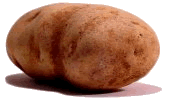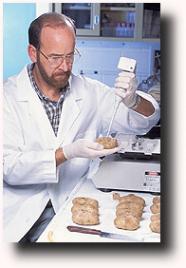
 |
|||||||||||||
|
A
"Bio-Bandage" for Banged-Up Potatoes
|
|||||||||||||
|
There's nothing like hot, creamy mashed potatoes with some butter sliding off the side. But maybe you've noticed that while peeling those potatoes, Mom or Dad ended up throwing some out because of a black, crusty-looking rot inside. |
|||||||||||||
|
One culprit is called the dry rot fungus. It usually grows inside the spuds by entering nicks on their skin. These small cuts happen when potatoes are dug up in the field or trucked off to storage houses. Most
potatoes with dry rot are
removed from market long before consumers buy them. But the Now, researchers are hoping to keep the fungus out of potatoes by spraying them with a kind of biological "bandage." Normally, chemicals called fungicides are used. But lately, the dry rot fungus has become immune to the chemicals' effect. |
|||||||||||||
| Potato chips; hash browns; Tater Tots; baked and mashed potatoes. | |||||||||||||
|
To tackle the problem, Patricia Slininger and David Schisler have resorted to spraying the spuds with certain kinds of Pseudomonas (say "sue-doe MOAN-us") and other bacteria. |
|||||||||||||
|
Why bacteria? First, they're the fungus' natural rivals. Second, they like to grow on (colonize) areas where potato skins have been damaged. Third, the bacteria release natural antibiotics that stop the fungus from infecting the spud and rotting it. Last, the bacteria are harmless to both potatoes and people, says Slininger, the research leader for ARS' Crop Bioprotection Research Unit in Peoria, Illinois. Schisler is a plant pathologist there (Note: Both links will take you outside the story). |
|||||||||||||
|
Patricia Slininger looks at a potato slice with dry rot on its outer edge. |
|||||||||||||
 |
Other than being a bio-bandage, some of the bacteria help stop sprouting. The sprouts grow out of small lumps, called "eyes," on the potato's skin. Some of the bacteria can stop sprouting by as much as 77 percent. That's pretty good compared to CPIC, the shorthand name for a chemical sprout stopper that's used on about half the nation's $2.5 billion potato crop. CIPC stalls sprouting longer than the bacteria. But the chemical's use has raised environmental safety concerns. With a helping hand from science, the bacteria may soon offer a nature-based solution to both potato dry rot and sprouting. |
||||||||||||
| David Schisler squirts a potato with a solution of the fungus and the bacteria that fight them. | |||||||||||||
|
By Jan Suszkiw, Agricultural Research Service, Information Staff To top /Back
home to |
|||||||||||||
 |
|||||||||||||
|
|
|
||||||||||||
 U.S.
potato industry is forced to foot the bill, namely $250
million in yearly losses.
U.S.
potato industry is forced to foot the bill, namely $250
million in yearly losses.